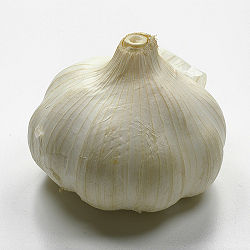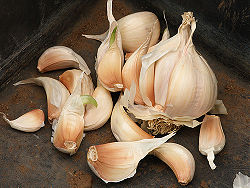Garlic
| Garlic |
|---|

|
| Scientific Classification |
|
| Binomial name |
|
Allium sativum |
| Image Description |
Garlic has been grown and cultivated by humans since 4000 BC. They are used in a wide range of ways such as food, medicine and etc. As the demand of garlics are amazingly high, they are produced in all over the world. They are cousin to onions, leeks, chives, and shallots. They are root vegetables with the bulb growing underground. There are two main types of garlics: soft neck and hard neck. Soft neck garlics are good for storing, while hard neck garlics are appropriate to eat. Therefore, growers mix those two types of garlics in gardens. They are usually planted in fall or early winter and harvested in mid-July or early-August.[1]
Anatomy
The garlic, usually being cultivated for commercial use, grows about 1 to 3 feet (30-90 cm) tall. The bulb, which is planted underground and the main part of medicinal uses, is divided into segments called cloves, and each bulb has 6 to 12 cloves. The sizes are different according to soil conditions. A stem grows to form flowers from the bulb and linear leaves. The flowers bloom in a umbrella-shaped form. Being affected by soil and chemicals, the flower cluster contains a variety of colors, purplish white, pink or reddish white. There are small bulbils among the flowers. [2]
Reproduction
The meadow garlics are usually planted in fall or early winter. Since the bulbs should be frozen at 40ºF for 40 days, it is not good to plant them in spring. They will derive energy from the ground and develop root in the fall before the ground freezes and use the energy to grow and develop size, leaves and bulbs. Later plating, less growing, so it is important not to plant them too late. In winter, they can also be planted two to three weeks after the ground first becomes frozen. The growers usually save 15 to 20 percent of crops to plant for the following year.
The garlics are produced vegetatively. It is important to consider size and quality when choosing the planting stocks. The seeds are actually produced by cloves of the bulbs. The biggest cloves are made from the best bulbs. In general, the cloves are planted in double row beds 30 inches apart on center and six inches of spacing between rows in the beds. The cloves should be planted with the pointed side facing up. They stop growing when the temperature hits 90ºF. Mulch is often used in production to help them survive in the winter, maintain soil moisture, protect soil erosion and control weeds. The growers normally start this in the winter and remove them in the spring. The scapes are cut after curling. In general, the garlics mature in this order from earliest to latest: Tuban, Asiatic, Artichoke, Rocambole, Creole, Glazed Purple Stripe, Purple Stripe, Marbled Purple Stripe, Porcelain, and Silverskin. To be stored, the garlics need to be tied in bundles of 10 to 15 and cured and dried for 10 to 14 days. They can be kept for 6 to 7 months in a condition of 32ºF to 40ºF and 65 to 70 percent humidity. It is significantly essential to keep this constant condition. [3]
Ecology
The garlics are grown best in well-drained lands with a lot of sun and nutrients. Like all other root crops, they are recommended to grow in rich, loose soil. On the other hand, if they are planted in heavy soil, they can very easily to rot. The pH of 6.8 to 7.2 is the most favorable. Sandy loam or loam soils are the most ideal textures for garlics. The garlics require a lot of water so irrigation may be essential in certain dry areas. However, too much water can damage the value of the garlics. The use of manure can highly help form an appropriate soil for garlics. [4]
History
The history of garlics has started from 4000 BC. The word garlic is from Old English garleac, which means spear leek. The garlics are originally native to Central Asia. Now they are mainly produced in Asia, Africa and Europe. Egyptians regarded them very valuable, worshiped and used them as currency and to set models of their bulbs in the tomb of King Tut. They also fed workers to grow their stamina when building the pyramids. Since then, they have been used for cooking ingredients, medical uses and many other ways. [5] However, it was not popular in United States in early twentieth century. In the 1940s, Americans realized the value of garlics and started to use them in many ways. During World War II, the garlics were used to disinfect wounds and cure other diseases. [6] The garlics also show up in lots of stories, that are passed down from the ancient age. For example, there is a Korean story about a woman, who was a bear and later became a human after eating mugwort and garlic for 100 days in a cave. She did not see the sun and soon bore a child, who created the first country in Korea. Like that, the garlics have been very close and important in humans' lives.
Gallery
 Browse |
References
- Garlic: Organic Production Janet Bachmann. ATTRA. 04/07/08
- Growing Garlic in Minnesota University of Minnesota. 2009
- Garlic Facts Saratoga Garlic Company.







